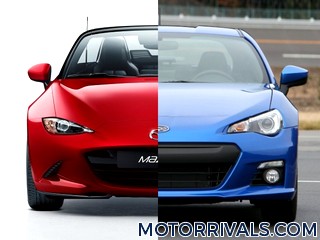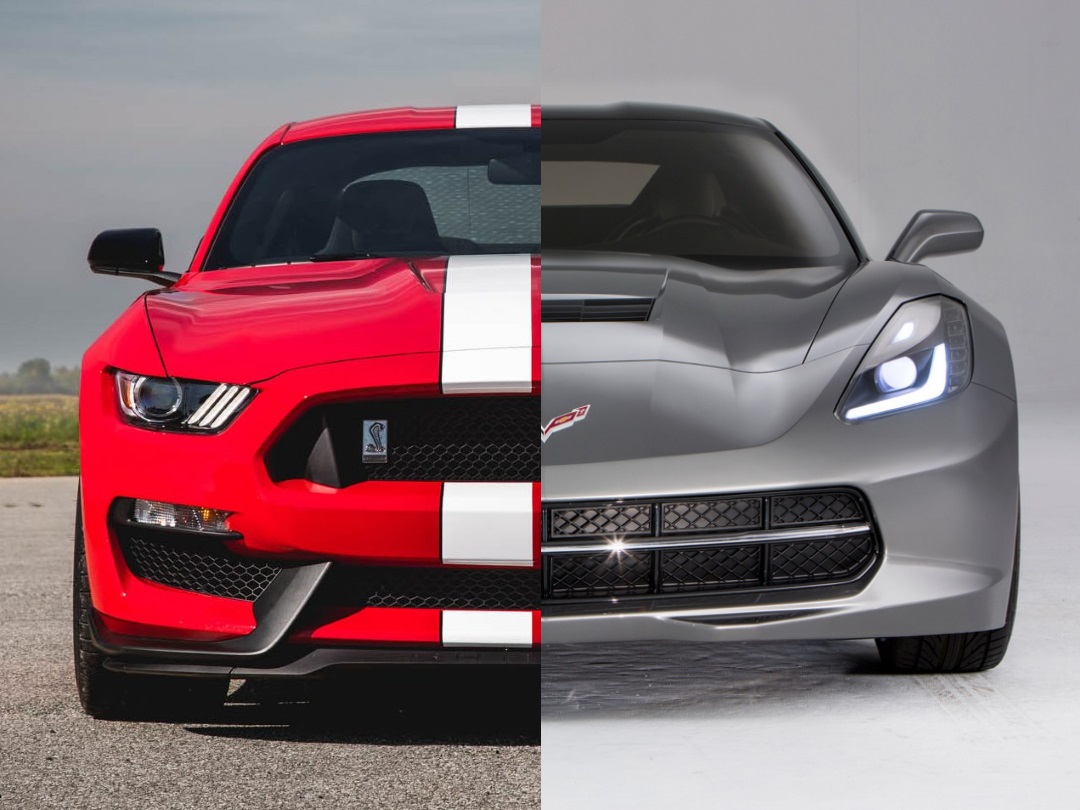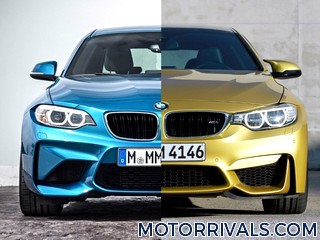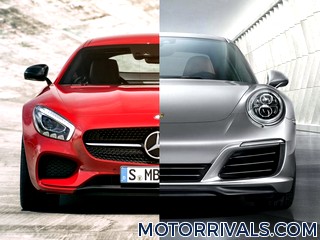2016 Chevrolet Camaro vs 2016 Ford Mustang
Chevrolet Press Release Highlights
The sixth-generation Chevrolet Camaro offers higher levels of
performance, technology and refinement and is designed to maintain the
sporty car segment leadership earned over the past years. The new Camaro
provides a faster, more nimble driving experience, enabled by an
all-new, lighter architecture and a broader powertrain range. Camaro's
leaner, stiffer platform and slightly smaller dimensions are accentuated
by a dramatic, sculpted exterior. Meticulously tuned in the wind tunnel,
the exterior contributes to performance through reduced aerodynamic lift
for better handling while enhancing efficiency. A driver-focused
interior integrates class-leading control technologies, including a new
Driver Mode Selector, configurable instrument cluster and a customizable
ambient lighting feature. Only two parts carry over from the
fifth-generation Camaro to the new Gen Six: the rear bowtie emblem and
the SS badge. The exterior of the Camaro is more sculpted and more
muscular effect that makes the new car look significantly lower and
wider than before, even though it is within two inches of the exterior
dimensions of the current Camaro. In many cases, the exterior design not
only communicates the performance capabilities of the new Camaro, but
contributes to them. For example, the teams spent more than 350 hours
testing the Camaro in the wind tunnel, meticulously tailoring the
exterior to improve cooling and reduce aerodynamic lift and drag.
Chevrolet testing shows the all-new, 455-hp (336 kW) Camaro SS coupe – the most powerful Camaro SS ever – sprints from 0-60 mph in 4.0 seconds and covers the quarter-mile in 12.3 seconds, when equipped with the all-new eight-speed paddle-shift automatic transmission.
The other Gen Six Camaro coupe models are commensurately quick, with the 275-hp (205) 2.0L Turbo delivering 5.4-second 0-60 performance and a 14.0-second quarter-mile, with the six-speed manual. With the available, 335-hp (250 kW) 3.6L V-6 and eight-speed automatic, the Camaro zips to 60 mph in 5.1 seconds and down the quarter-mile in only 13.5 seconds.
In their quest to make the 2016 Camaro as lean as possible, engineers and designers evaluated every aspect of its architecture - already the most mass-efficient ever created by GM - and supporting elements, saving grams here and pounds there that contributes to the car's lower curb weight. As a result, the total curb weight for Camaro has been reduced by more than 200 pounds (90 kg).
The Camaro features a new, multi-link MacPherson strut front suspension with Camaro-specific geometry. The double-pivot design provides a more precise feeling of control, including more linear and communicative feel from the quick-ratio electric power steering system. At the rear, a new five-link independent suspension yields outstanding wheel control and reduces "squat" during acceleration.
In addition, the Magnetic Ride Control is available on the Camaro SS for the first time. Previously limited to the Camaro ZL1, the active suspension reads road and driving conditions 1,000 times per second, and automatically adjusts the damper settings to optimize ride comfort and control.
All Camaro models offer Brembo brakes - they're standard on SS - optimized for the car's mass and performance capability. On Camaro LT, the available brakes include 12.6-inch (320 mm) front rotors with four-piston calipers and 12.4-inch (315 mm) rear rotors with single-piston sliding calipers. Camaro SS employs 13.6-inch (345 mm) front rotors with four-piston fixed calipers and 13.3-inch (338 mm) rear rotors with four-piston fixed calipers.
Another eight-inch screen, integrated in the center of the instrument panel, serves as the interface for the enhanced, next-generation MyLink system.
An electronic parking brake replaces the previous mechanical parking brake handle. This enabled the cup holders to be repositioned for improved range of motion when shifting in manual-transmission models.
An available, segment-first LED ambient lighting system, integrated in the dash, door panels and center console, offers 24 different colors, as well as fade and transition effects that spread across the interior. There's even a theatrical "car show" mode that cycles randomly through the entire color spectrum when the Camaro is parked.
Powertrain
Six all-new powertrain combinations are offered, including a 2.0L Turbo, an all-new 3.6L V-6 and the LT1 6.2L V-8, which is SAE-certified at 455 horsepower (339 kW) and 455 lb-ft of torque (617 Nm) - for the most powerful Camaro SS ever. Each engine is available with a six-speed manual or eight-speed automatic transmission.Chevrolet testing shows the all-new, 455-hp (336 kW) Camaro SS coupe – the most powerful Camaro SS ever – sprints from 0-60 mph in 4.0 seconds and covers the quarter-mile in 12.3 seconds, when equipped with the all-new eight-speed paddle-shift automatic transmission.
The other Gen Six Camaro coupe models are commensurately quick, with the 275-hp (205) 2.0L Turbo delivering 5.4-second 0-60 performance and a 14.0-second quarter-mile, with the six-speed manual. With the available, 335-hp (250 kW) 3.6L V-6 and eight-speed automatic, the Camaro zips to 60 mph in 5.1 seconds and down the quarter-mile in only 13.5 seconds.
Chassis
Approximately 70 percent of the architectural components are unique to Camaro. Through extensive computer-aided engineering, structural rigidity was increased by 28 percent, while the body-in-white mass was reduced by 133 pounds (60.5 kg).In their quest to make the 2016 Camaro as lean as possible, engineers and designers evaluated every aspect of its architecture - already the most mass-efficient ever created by GM - and supporting elements, saving grams here and pounds there that contributes to the car's lower curb weight. As a result, the total curb weight for Camaro has been reduced by more than 200 pounds (90 kg).
The Camaro features a new, multi-link MacPherson strut front suspension with Camaro-specific geometry. The double-pivot design provides a more precise feeling of control, including more linear and communicative feel from the quick-ratio electric power steering system. At the rear, a new five-link independent suspension yields outstanding wheel control and reduces "squat" during acceleration.
In addition, the Magnetic Ride Control is available on the Camaro SS for the first time. Previously limited to the Camaro ZL1, the active suspension reads road and driving conditions 1,000 times per second, and automatically adjusts the damper settings to optimize ride comfort and control.
All Camaro models offer Brembo brakes - they're standard on SS - optimized for the car's mass and performance capability. On Camaro LT, the available brakes include 12.6-inch (320 mm) front rotors with four-piston calipers and 12.4-inch (315 mm) rear rotors with single-piston sliding calipers. Camaro SS employs 13.6-inch (345 mm) front rotors with four-piston fixed calipers and 13.3-inch (338 mm) rear rotors with four-piston fixed calipers.
Technology
The instrument cluster features analog instruments to provide the driver with essential performance information, as well as an available eight-inch-diagonal high-definition center screen that can be configured to provide additional information including navigation, performance, and infotainment features.Another eight-inch screen, integrated in the center of the instrument panel, serves as the interface for the enhanced, next-generation MyLink system.
An electronic parking brake replaces the previous mechanical parking brake handle. This enabled the cup holders to be repositioned for improved range of motion when shifting in manual-transmission models.
An available, segment-first LED ambient lighting system, integrated in the dash, door panels and center console, offers 24 different colors, as well as fade and transition effects that spread across the interior. There's even a theatrical "car show" mode that cycles randomly through the entire color spectrum when the Camaro is parked.
Ford Press Release Highlights
The next chapter in the life of the iconic pony car begins as the
all-new Ford Mustang - loaded with innovative technologies and
delivering world-class levels of performance. The clean-sheet design of
both the Mustang fastback and convertible evokes the essential character
of the brand, retaining key design elements - including the long
sculpted hood and short rear deck - with contemporary execution. Mustang
convertible drivers will appreciate the standard multilayer insulated
cloth top that gives the car a more upscale appearance and a quieter
cabin. The new top lowers twice as fast as before, and has a sleeker
profile when folded for open-air motoring. The information and controls
an active driver needs are all readily accessible in the
aviation-inspired cockpit, which is executed with the highest degree of
craftsmanship ever found in a Mustang. Large, clear instrumentation puts
vehicle information right in front of the driver in the roomier cabin,
while improved ergonomics and tactile switches and knobs provide better
control. The added width and a new rear suspension contribute to
improved shoulder and hip room for passengers, and a more usefully
shaped trunk can accommodate two golf bags. The way the Mustang looks,
drives and sounds is key to the visceral experience that makes drivers
just want to get in and hit the road. With more options to choose from,
there is a Mustang to fit any lifestyle.
With at least 300 horsepower (304 PS) and 270 lb.-ft. (366 Nm) of torque on tap from the standard 3.7-liter V6, even the most accessible Mustang delivers the performance customers expect.
The Ford Mustang GT continues with the latest edition of the throaty 5.0-liter V8, now featuring an upgraded valvetrain and cylinder heads that yield more than 420 horsepower (426 PS) and 390 lb.-ft. (529 Nm) of torque. A new intake manifold improves low-speed breathing for better fuel economy, idle stability and emissions. It now includes charge motion control valves to partially close off port flow at lower engine speeds.
No Ford Mustang engine lineup would be complete without a great V8 engine at its core. The 5.0-liter V8 powers into a new generation with a host of upgrades that enable it to breathe better, especially at higher engine speeds. Many of these changes are derived from the lessons learned in developing the special edition 2013 Mustang Boss 302.
More than most drivers, Mustang owners like to take control and shift for themselves. Whether they select a fully manual gearbox or the updated automatic transmission, the experience will be better than in any previous pony. The Getrag manual has a new shift linkage design for shorter throws and improved precision. The shift lever is now positioned closer to the driver and away from the cup-holders so the driver has a clear path for shifting.
The Mustang blends outstanding all-around performance and everyday usability. Drivers who prefer to let the car handle the shifting during their daily work run, but still want to take control when the roads get twisty, will appreciate the new steering-wheel-mounted shift paddles with rev-matching downshifts that are now standard with the Select-Shift six-speed automatic transmission.
The advanced new Ford-developed stability control system is tuned to maximize Mustang's dynamic capabilities. When the time comes to turn up the wick at the track, the Ford Mustang GT includes standard launch control that enables drivers to achieve smooth, consistent starts every time.
The feeling of freedom and confidence Mustang instills in its drivers is amplified when they can take control of how the car behaves. On a twisty back road or a weekend track day, the driver can tap the toggle switches on the console to quickly adjust steering effort, engine response, and transmission and electronic stability control settings using the available Selectable Drive Modes to create the perfect Mustang at any time.
When it's time to back off and relax for the drive home, available advanced driver-assist features including Blind Spot Information System with cross-traffic alert and adaptive cruise control can help ease the load, while SYNC AppLink™ lets drivers control their smartphone apps to listen to their favorite form of entertainment.
Powertrain
The upgraded V6 and V8 are joined by an all-new 2.3-liter EcoBoost® engine that brings state-of-the-art technology to the Mustang. The newest member of Ford's global family of EcoBoost engines, the 2.3-liter includes direct fuel injection, twin independent variable camshaft timing and turbocharging to produce big-engine power and torque with improved fuel efficiency. The cylinder head features an integrated exhaust manifold that separates the inner and outer pairs of cylinders into each inlet passage to the turbo. More than 305 horsepower and 300 lb.-ft. of torque is pumped out from such a small engine.With at least 300 horsepower (304 PS) and 270 lb.-ft. (366 Nm) of torque on tap from the standard 3.7-liter V6, even the most accessible Mustang delivers the performance customers expect.
The Ford Mustang GT continues with the latest edition of the throaty 5.0-liter V8, now featuring an upgraded valvetrain and cylinder heads that yield more than 420 horsepower (426 PS) and 390 lb.-ft. (529 Nm) of torque. A new intake manifold improves low-speed breathing for better fuel economy, idle stability and emissions. It now includes charge motion control valves to partially close off port flow at lower engine speeds.
No Ford Mustang engine lineup would be complete without a great V8 engine at its core. The 5.0-liter V8 powers into a new generation with a host of upgrades that enable it to breathe better, especially at higher engine speeds. Many of these changes are derived from the lessons learned in developing the special edition 2013 Mustang Boss 302.
More than most drivers, Mustang owners like to take control and shift for themselves. Whether they select a fully manual gearbox or the updated automatic transmission, the experience will be better than in any previous pony. The Getrag manual has a new shift linkage design for shorter throws and improved precision. The shift lever is now positioned closer to the driver and away from the cup-holders so the driver has a clear path for shifting.
The Mustang blends outstanding all-around performance and everyday usability. Drivers who prefer to let the car handle the shifting during their daily work run, but still want to take control when the roads get twisty, will appreciate the new steering-wheel-mounted shift paddles with rev-matching downshifts that are now standard with the Select-Shift six-speed automatic transmission.
Chassis
The Mustang features all-new front and rear suspension systems. At the front, a new perimeter subframe helps to stiffen the structure while reducing mass, providing a better foundation for more predictable wheel control that benefits handling, steering and ride. The new double-ball-joint front MacPherson strut system also enables the use of larger, more powerful brakes. This is expected to be the best stopping Mustang yet, with three available brake packages. At the rear is an all-new integral-link independent rear suspension. The geometry, springs, dampers and bushings all have been specifically modified and tuned for this high-performance application. New aluminum rear knuckles help reduce unsprung mass for improved ride and handling.The advanced new Ford-developed stability control system is tuned to maximize Mustang's dynamic capabilities. When the time comes to turn up the wick at the track, the Ford Mustang GT includes standard launch control that enables drivers to achieve smooth, consistent starts every time.
The feeling of freedom and confidence Mustang instills in its drivers is amplified when they can take control of how the car behaves. On a twisty back road or a weekend track day, the driver can tap the toggle switches on the console to quickly adjust steering effort, engine response, and transmission and electronic stability control settings using the available Selectable Drive Modes to create the perfect Mustang at any time.
Technology
The all-new Ford Mustang features a significant amount of innovative technologies providing drivers with enhanced information, control and connectivity when they want it. From Intelligent Access with push-button start to SYNC® and MyKey® in every Mustang built, plus available Track Apps, MyColor gauges and new Shaker Pro audio system, drivers will be able to customize their time behind the wheel.When it's time to back off and relax for the drive home, available advanced driver-assist features including Blind Spot Information System with cross-traffic alert and adaptive cruise control can help ease the load, while SYNC AppLink™ lets drivers control their smartphone apps to listen to their favorite form of entertainment.






















